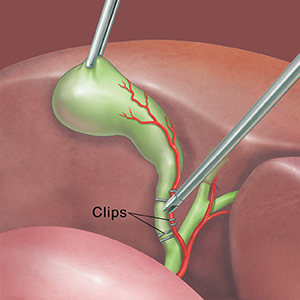A
B
C
D
E
F
G
H
I
J
K
L
M
N
O
P
Q
R
S
T
U
V
W
X
Y
Z
Click a letter to see a list of medical procedures beginning with that letter.
Click 'Back to Intro' to return to the beginning of this section.
Cholecystectomy
You’ve had painful attacks caused by gallstones. To treat the problem, your healthcare provider wants to remove your gallbladder. This surgery is called a cholecystectomy. Taking out the gallbladder can ease pain. It will also help stop future attacks. You can live a healthy life without your gallbladder. You may also be able to go back to eating foods you liked before your gallbladder problems started.
Before your surgery
To get ready:
-
Tell your provider what medicines you take. Include both prescription and over-the-counter medicines. Also include vitamins, herbs, and supplements. Tell them if you take prescription blood thinners. This includes warfarin, clopidogrel, and aspirin.
-
Have any tests your provider asks for, such as blood work or imaging.
-
Follow all directions you're given for not eating or drinking before your surgery. You may need to take some medicine with sips of water. Talk with your provider.
-
You'll be asked to sign an informed consent document. Signing the form means you understand the surgery. It means you agree to the procedure. Be sure all of your questions are answered before you sign the form.
The day of surgery
When you arrive, you'll get ready for surgery:
-
An IV (intravenous) line will be put into a vein in your arm or hand. This gives you fluids and medicine.
-
An anesthesiologist will talk with you about anesthesia. This is medicine used to prevent pain. You'll get general anesthesia. This puts you into a deep sleep during the procedure.
During surgery
There are 2 methods for taking out the gallbladder. Your healthcare provider will choose which way is best for you:
-
Laparoscopic cholecystectomy. This is most common. During surgery, 2 to 4 small cuts (incisions) are made. A thin tube with a camera is used. This is called a laparoscope. The scope is put through 1 of the cuts. It sends images to a video screen. Tiny tools for surgery are put through other cuts. The gallbladder is taken out using the scope and these tools.
-
Open cholecystectomy. One larger incision is made. The surgeon sees and works through this cut. Open surgery is most often used when scarring or other factors make it a better choice for you.
In some cases, your provider may need to change from laparoscopic to open surgery during the procedure.
 |
| Clips close off the duct connecting the gallbladder to the bile duct. The gallbladder is then removed. |
After surgery
You'll be sent to a recovery room to wake up from the anesthesia. You'll likely go home the same day. In some cases, you'll need to stay overnight. If you had open cholecystectomy, you may need to stay in the hospital for a few days. When you're released to go home, have a family member or friend ready to drive you. If you're told to take medicines after surgery, do so as told. If you're told to do breathing exercises, do them as advised. You'll be scheduled for a follow-up visit.
Risks and possible complications of gallbladder surgery
All surgeries have risks. The risks of gallbladder surgery include:
When to call the healthcare provider
Call your surgeon if you have these symptoms:
-
Fever of 100.4°F (38.0°C) or higher, or as advised by your provider
-
Redness, pain, or fluid leaking at the incision site
-
Yellow color to your skin or eyes (jaundice)
-
Severe pain or cramping in your belly
-
Vomiting that continues and unable to keep down fluids
-
No bowel movement within 3 days
-
Trouble peeing
-
Mild or short-term rectal bleeding
-
Leg swelling
Call 911
Call 911 if you have any of these:
Online Medical Reviewer:
Heather M Trevino BSN RNC
Online Medical Reviewer:
Robyn Zercher FNP
Online Medical Reviewer:
Ronald Karlin MD
Date Last Reviewed:
4/1/2024
© 2000-2025 The StayWell Company, LLC. All rights reserved. This information is not intended as a substitute for professional medical care. Always follow your healthcare professional's instructions.